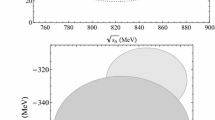Summary
We show that a combination of current algebra and the pole model for K→3π decay is incompatible with experiment unless off-mass-shell corrections are unexpectedly large. Without such corrections the pole terms give much too large an amplitude and do not give all the zeros required by current algebra.
Riassunto
Si dimostra che una combinazione dell’algebra delle correnti e del modello a poli per il decadimento K→3π non è compatibile con i dati sperimentali a meno che le correzioni fuori dello strato delle masse non siano inaspettatamente grandi. Senza tali correzioni i termini dei poli danno un’ampiezza troppo grande e non danno tutti gli zeri richiesti dall’algebra delle correnti.
Реэуме
Мы покаэываем, что комбинация алгебры токов и полюсной модели для распада K→π является несовместной с Экспериментальными Реэультатами, если только поправки вне массовой поверхности не являются неожиданно больщими. Беэ учета таких поправок полюсные члены дают слищком больщую амплитуду и не дают всех нулей, требуемых алгеброй токов.
Similar content being viewed by others
References
M. A. B. Bég andP. C. De Celles:Phys. Rev. Lett.,8, 46 (1962).
G. Barton andS. P. Rosen:Phys. Rev. Lett.,8, 414 (1962).
C. Kacser:Phys. Rev.,130, 355 (1963).
S. Hori, S. Oneda, S. Chiba andA. Wakasa:Phys. Lett.,5, 339 (1963).
S. Oneda, Y. S. Kim andL. M. Kaplan:Nuovo Cimento,34, 655 (1964).
This does not necessarily imply that current algebra is wrong in η decay. Assumptions which have been successfully applied to K→3π forbid η→3π (10); off-mass-shell corrections or higher-order terms must be invoked to give a nonzero rate so that it is, perhaps, the large rate and not the absence of zeros which constitutes the theoretical problem.
D. G. Sutherland:Phys. Lett.,23, 384 (1966).
Some variation is necessary in models with a spurion when both pions have zero momentum and the kaon stays on its mass shell (11) because of the kaon pole attached to the spurion line (12) (this is also discussed in ref. (13)).
B. D’Espagnat andJ. Iliopoulos:Phys. Lett.,21, 232 (1966).
C. Itzykson, M. Jacob andG. Mahoux:Suppl. Nuovo Cimento,3, 978 (1967).
S. Weinberg:Phys. Rev. Lett.,17, 616 (1966).
K. Kawarabayashi, S. Kitakado andH. Yabuki:Phys. Lett.,28 B, 432 (1969).
This gives ππ and πK scattering lengths within ten per cent of Weinberg’s values (15), so that it is inessential which we normalize to.
Author information
Authors and Affiliations
Rights and permissions
About this article
Cite this article
Jacob, M., Llewellyn Smith, C.H. & Pokorski, S. K→3π spectrum and pole dominance. Nuovo Cimento A (1965-1970) 63, 574–580 (1969). https://doi.org/10.1007/BF02756234
Received:
Published:
Issue Date:
DOI: https://doi.org/10.1007/BF02756234



